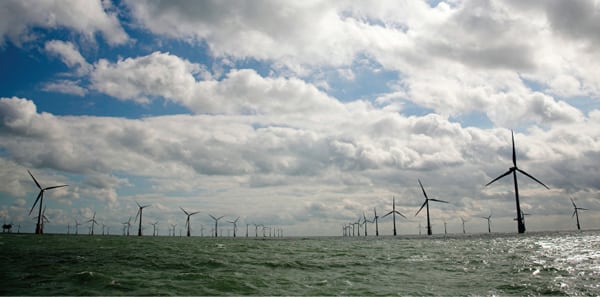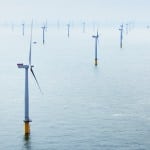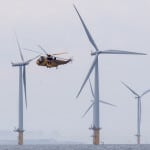Swedish company Vattenfall in late September officially opened the 300-MW Thanet Offshore Wind Farm in southeast England. Covering an area of 35 square kilometers, the installation comprising 100 Vestas V90 turbines, each 115 meters (m) high, is the largest offshore wind farm in the world to date (Figure 3). Though it was built at a “significant investment” (estimates point to project costs of nearly £900 million [US$1.6 billion]) within two years, the wind farm is expected to operate at least 25 years, Vattenfall said.
 |
| 3. When the wind is fair. Vattenfall opened the 300-MW Thanet Offshore Wind Farm off the southeast coast of England this September. Covering an area of 35 square kilometers, the installation of 100 turbines—each 115 meters high—is the largest offshore wind farm to date. Courtesy: Vattenfall |
The wind farm’s opening was hailed by UK government officials, who said that it boosted the UK’s wind capacity to more than 5 GW: 1,341 MW coming from installed offshore wind capacity and 3,715 MW from onshore wind.
Lobby group Renewable UK estimates that wind energy now accounts for 4% of the nation’s electricity consumption, and it predicts that, led by onshore wind, wind’s contribution will increase to 30% over the next decade.
Offshore wind in the UK is slated to continue its exponential growth, making a major contribution to the nation’s efforts to meet renewable energy targets for 2020—but not without repercussions to its economy, warned government think tank UK Energy Research Centre (UKERC). In a report published this September, the organization pointed out that offshore wind remains by far the most expensive source of power—with costs incurred that are 90% more than fossil fuel generators and 50% more than nuclear. The country also currently imports 80% of equipment and services from abroad, it noted. It concluded that government policies could do more to reduce sector costs.
“Ten years ago, when offshore wind technology was first deployed in UK waters, capital and generation costs were expected to fall substantially over time. Since then, producing electricity has become generally more expensive, but the rise in offshore wind costs has been particularly dramatic,” UKERC said. “Costs went up in part because of currency and commodity price movements but also because of supply chain shortages and bottlenecks. Planning delays also added to developers’ budgets and undermined supply chain confidence.”
UKERC calculated that a wind farm like Vattenfall’s Thanet array would cost £149/MWh over its 25-year lifespan. That compares with £80/MWh for coal and gas, and £97/MWh for nuclear power. The group said that at £88/MWh, onshore wind was almost as efficient as fossil fuels.
Wary of how overhead costs could affect the sector, other UK think tanks have been attempting to inspire new ways to cut costs. Carbon Trust in September, for example, launched a global competition to spur new ideas on how to allow workers to make transfers from service boats to offshore wind turbines in sea conditions with three-meter-high waves. The publicly funded organization estimates that maximizing worker safety in choppy waters could cut the construction and maintenance bill by nearly £3 billion. Successful entrants could win up to £100,000 each to support development of their ideas.
—Sonal Patel is POWER’s senior writer.










